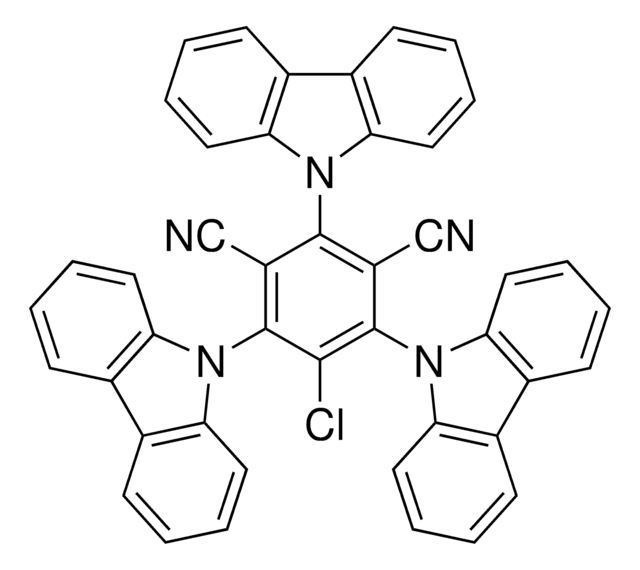932434
TcTa
≥99% (HPLC)
Synonyme(s) :
4,4′,4′′-Tri-9-carbazolyltriphenylamine, 4,4′,4′′-tris(carbazol-9-yl)-triphenylamine, 4,4′,4-Tris(carbazol-9-yl)triphenylamine, Tris(4-(9H-carbazol-9-yl)phenyl)amine
About This Item
Produits recommandés
Qualité
sublimed grade
Niveau de qualité
Description
μh ≈ 3.0 x 10-4 cm2 V−1 s−1
μe ≈ 1.0 x 10-8 cm2 V−1 s−1
Pureté
≥99% (HPLC)
Perte
0.5% TGA, > 410 °C (weight loss)
Pf
299 °C
Solubilité
THF: soluble
chloroform: soluble
dichloromethane: soluble
λmax
293 nm±5 nm in THF
326 nm±5 nm in THF
Fluorescence
λem 385 nm±10 nm in THF
Énergie orbitale
HOMO 5.8 eV
LUMO 2.4 eV
Chaîne SMILES
c1ccc2c(c1)n(-c3ccc(cc3)N(c4ccc(cc4)-n5c6ccccc6c7ccccc57)c8ccc(cc8)-n9c%10ccccc%10c%11ccccc9%11)c%12ccccc2%12
InChI
1S/C54H36N4/c1-7-19-49-43(13-1)44-14-2-8-20-50(44)56(49)40-31-25-37(26-32-40)55(38-27-33-41(34-28-38)57-51-21-9-3-15-45(51)46-16-4-10-22-52(46)57)39-29-35-42(36-30-39)58-53-23-11-5-17-47(53)48-18-6-12-24-54(48)58/h1-36H
Clé InChI
AWXGSYPUMWKTBR-UHFFFAOYSA-N
Catégories apparentées
Application
Mention d'avertissement
Warning
Mentions de danger
Conseils de prudence
Classification des risques
Eye Irrit. 2 - Skin Irrit. 2 - STOT SE 3
Organes cibles
Respiratory system
Code de la classe de stockage
11 - Combustible Solids
Classe de danger pour l'eau (WGK)
WGK 3
Point d'éclair (°F)
Not applicable
Point d'éclair (°C)
Not applicable
Certificats d'analyse (COA)
Recherchez un Certificats d'analyse (COA) en saisissant le numéro de lot du produit. Les numéros de lot figurent sur l'étiquette du produit après les mots "Lot" ou "Batch".
Déjà en possession de ce produit ?
Retrouvez la documentation relative aux produits que vous avez récemment achetés dans la Bibliothèque de documents.
Notre équipe de scientifiques dispose d'une expérience dans tous les secteurs de la recherche, notamment en sciences de la vie, science des matériaux, synthèse chimique, chromatographie, analyse et dans de nombreux autres domaines..
Contacter notre Service technique


![Di-[4-(N,N-di-p-tolyl-amino)-phenyl]cyclohexane ≥97% (HPLC)](/deepweb/assets/sigmaaldrich/product/structures/111/787/16bde1ce-c76d-46d6-9e1f-9ce09f82d038/640/16bde1ce-c76d-46d6-9e1f-9ce09f82d038.png)



![(Ir[dF(CF3)ppy]2(dtbpy))PF6](/deepweb/assets/sigmaaldrich/product/structures/982/913/02dd8ddd-6deb-40a0-ab9b-07b18f1abb09/640/02dd8ddd-6deb-40a0-ab9b-07b18f1abb09.png)


